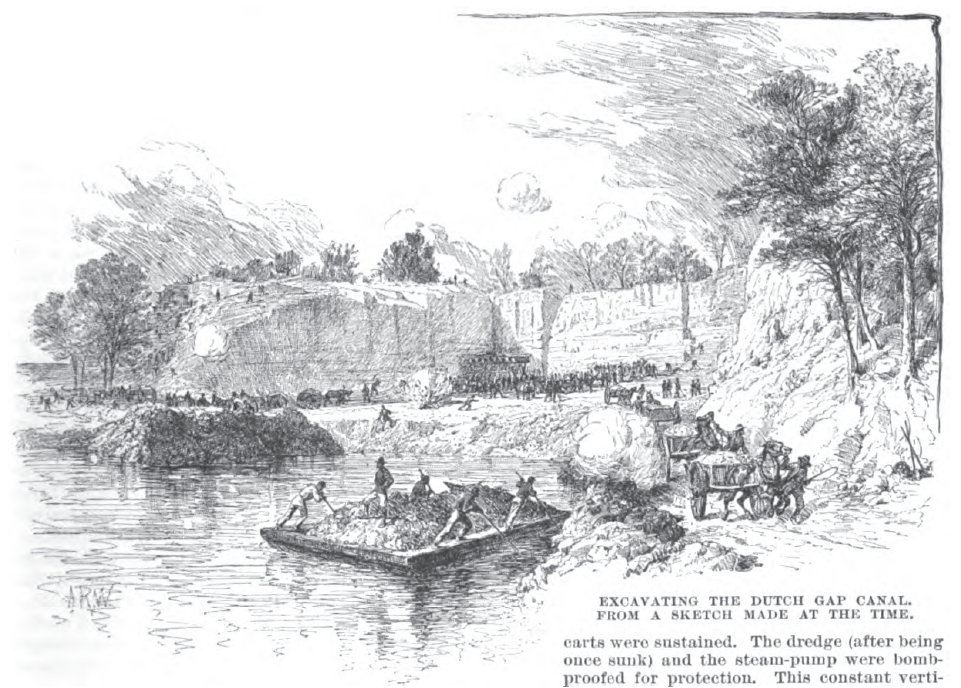GENERAL GRANT ON THE SIEGE OF PETERSBURG.1
EXTRACT FROM LIEUTENANT-GENERAL U. S. GRANT’S REPORT. DATED JULY 22D, 1865.
[SEE ALSO PP. 145-151.]
On the 16th [of June, 1864], the enemy, to reenforce Petersburg, withdrew from a part of his intrenchment in front of Bermuda Hundred, expecting, no doubt, to get troops from north of the James to take the place of those withdrawn before we could discover it. General Butler, taking advantage of this, at once moved a force on the railroad between Petersburg and Richmond. As soon as I was apprised of the advantage thus gained, to retain it I ordered two divisions of the Sixth Corps, General Wright commanding, that were embarking at Wilcox’s Landing, under orders for City Point, to report to General Butler at Bermuda Hundred, of which General Butler was notified, and the importance of holding a position in advance of the present line urged upon him.
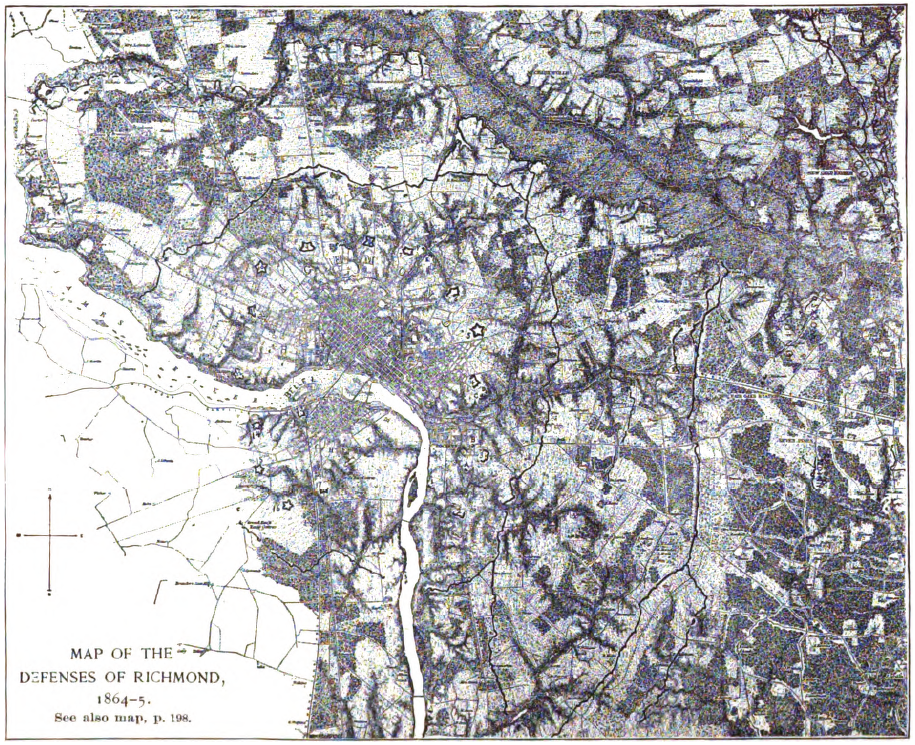
At the request of the editors, the following account of the Dutch Gap Canal has been prepared by General P. S. Michie, engineer in charge of the work:
“The strong defensive lines of Bermuda Hundred, behind which the Army of the James retreated after its repulse at Drewry’s Bluff, May 16th, 1864, were badly chosen, as their location permitted the Confederates to occupy an equally strong line, and thus to prevent any active operations on the part of this army against the Richmond and Petersburg Railroad. The powerful Confederate battery Dansler completely commanded Trout Reach — a wide, shallow part of the James River on the north flank of the contending lines. This barred all approach toward Richmond on the part of the United States war vessels. General Butler, conceiving the idea of cutting a canal through the narrow neck of land, known as Dutch Gap, for the passage of the monitors, directed me to report on the practicability of this project. The report being favorable, ground was broken August 10th, 1864. The canal, cutting off 4 3/4 miles of river navigation, was only 174 yards long — the excavation being 43 yards wide at the top, 27 yards at water-level, and 13.5 yards at a depth of 15 feet below water-level; 31 yards deep at tho north-west end and nearly 12 yards at the south-east end; the total excavation being very nearly 67,000 cubic yards. While no serious civil-engineering difficulties occurred, the troops employed were constantly subjected to a severe continuous fire, first of heavy rifled guns and afterward of mortars. The casualties were continuous throughout, on one occasion resulting in twelve killed and forty wounded; in addition, great losses in mules, horses, and
carts were sustained. The dredge (after being once sunk) and the steam-pump were bomb-proofed for protection. This constant vertical fire from mortar-batteries only twelve hundred yards distant delayed the work beyond anticipation, causing frequent suspension of all labor. The troops seeking cover in earthen dug-outs that covered the site of the work were also undergoing constant discomfort and exposure. The greater part of the excavation was done by colored troops, who displayed the greatest courage and fortitude, and maintained under the most trying circumstances their usual good humor and cheerful disposition. Owing to various causes, and especially to the capture by General Butler of the outer line of the Richmond defenses on the 29th of September, the importance of the canal project sensibly diminished; therefore the work was much delayed, was subject to indifferent management, and was not ultimately completed until December 30th, 1864. The rather large bulkhead containing nearly 6000 cubic yards of earth was mined and charged with 12,000 pounds of powder, distributed in four charges, one being 25 feet, and three 15 feet, below the water-level. At 3:50 P. M., January 1st, 1865, these mines were exploded by means of a Gomez fulminate fuse so arranged as to give a point of ignition for every one hundred pounds of powder. The condition of the canal in November is well delineated in the accompanying cut. The bombproof steam-pump is shown in the far corner, and the bulkhead, separated from the adjacent embankment by vertical trendies, is that which was mined and blown up. After the explosion the debris at the northwest end was partially removed by means of a steam-dredge. This canal was not of service during the war, but was subsequently enlarged and perfected, and became the usual channel for the passage of vessels.”

About 2 o’clock in the afternoon General Butler was forced back to the line the enemy had withdrawn from in the morning. General Wright, with his two divisions, joined General Butler on the forenoon of the 17th, the latter still holding with a strong picket-line the enemy’s works. But instead of putting these divisions into the enemy’s works to hold them he permitted them to halt and rest some distance in the rear of his own line. Between 4 and 5 o’clock in the afternoon the enemy attacked and drove in his pickets and re-occupied his old line.
On the night of the 20th and morning of the 21st a lodgment was effected by General Butler, with one brigade of infantry, on the north bank of the James, at Deep Bottom, and connected by pontoon-bridge with Bermuda Hundred.
On the 19th General Sheridan, on his return from his expedition against the Virginia Central Railroad [see p. 233], arrived at the White House just as the enemy’s cavalry was about to attack it, and compelled it to retire. . . . After breaking up the depot at that place he moved to the James River. which he reached safely after heavy fighting. He commenced crossing on the 25th, near Fort Powhatan, without further molestation, and rejoined the Army of the Potomac.
On the 22d [of June] General Wilson, with his own division of cavalry of the Army of the Potomac and General Kautz’s division of cavalry of the Army of the James, moved against the enemy’s railroads south of Richmond. [See p. 535.] …
With a view of cutting the enemy’s railroad from near Richmond to the Anna rivers, and making him wary of the situation of his army in the Shenandoah, and in the event of failure in this, to take advantage of his necessary withdrawal of troops from Petersburg, to explode a mine that had been prepared in front of the Ninth Corps and assault the enemy’s lines at that place, on the night of the 26th of July the Second Corps and two divisions of the cavalry corps and Kautz’s cavalry were crossed to the north bank of the James River and joined the force General Butler had there. On the 27th the enemy was driven from his in-
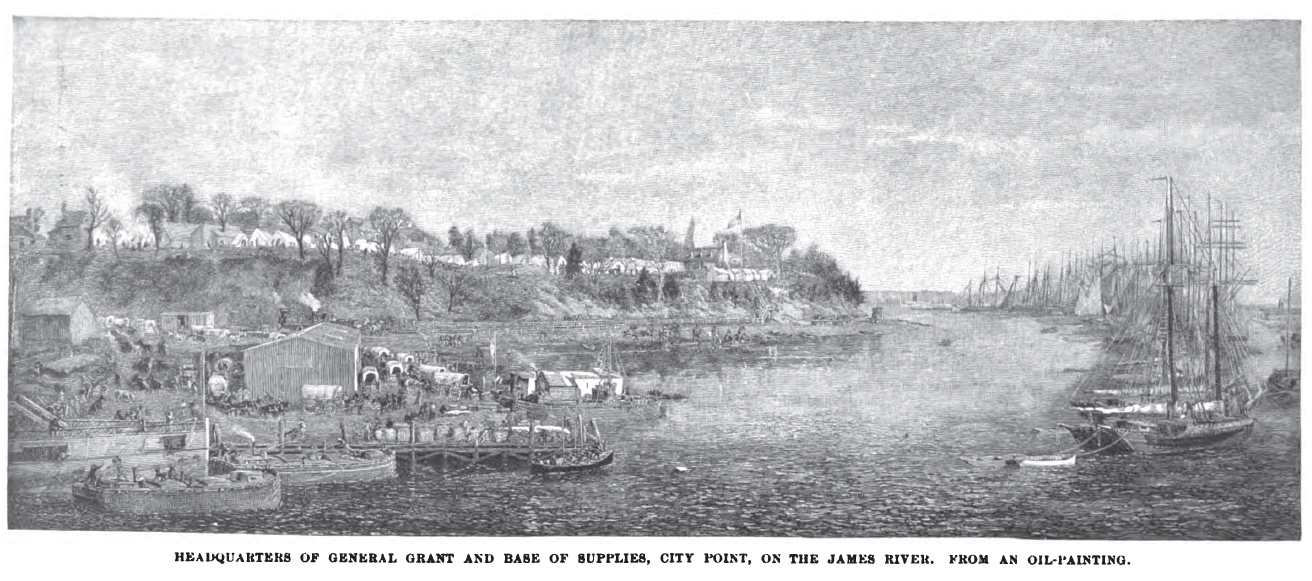
trenched position, with the loss of four pieces of artillery. [See map, p. 198.] On the 28th our lines were extended from Deep Bottom to New Market road, but in getting this position were attacked by the enemy in heavy force. The fighting lasted for several hours, resulting in considerable loss to both sides. The first object of this move having failed, by reason of the very large force thrown there by the enemy, I determined to take advantage of the diversion made by assaulting Petersburg before he could get his force back there. One division of the Second Corps was withdrawn on the night of the 28th, and moved during the night to the rear of the Eighteenth Corps, to relieve that corps in the line, that it might be foot-loose in the assault to be made. The other two divisions of the Second Corps and Sheridan’s cavalry were crossed over on the night of the 20th and moved in front of Petersburg. On the morning of the 30th, between 4 and 5 o’clock, the mine was sprung, blowing up a battery and most of a regiment, and the advance of the assaulting column, formed of the Ninth Corps, immediately took possession of the crater made by the explosion, and the line for some distance to the right and left of it, and a detached line in front of it, but for some cause failed to advance promptly to the ridge beyond. [See p. 540, et seq.] Had they done this, I have every reason to believe that Petersburg would have fallen. Other troops were immediately pushed forward, but the time consumed in getting them up enabled the enemy to rally from his surprise (which had been complete) and get forces to this point for its defense. The captured line thus held being untenable, and of no advantage to us, the troops were withdrawn, but not without heavy loss. Thus terminated in disaster what promised to be the most successful assault of the campaign. . . .
Reports from various sources led me to believe that the enemy had detached three divisions from Petersburg to reenforce Early in the Shenandoah Valley. [See pp. 500 and 522.] I therefore sent the Second Corps and Gregg’s division of cavalry, of the Army of the Potomac, and a force of General Butler’s army, on the night of the 13th of August, to threaten Richmond from the north side of the James, to prevent him from sending troops away, and, if possible, to draw back those sent. [See map, p. 198.] In this move we captured six pieces of artillery and several hundred prisoners, detained troops that were under marching orders, and ascertained that but one division (Kershaw’s) of the three reputed detached had gone.
The enemy having withdrawn heavily from Petersburg to resist this movement, the Fifth Corps, General Warren commanding, was moved out on the 18th, and took possession of the Weldon Railroad. [See p. 568.] During the day he had considerable fighting. To regain possession of the road
the enemy made repeated and desperate assaults, but was each time repulsed with great loss. On the night of the 20th the troops on the north side of the James were withdrawn, and Hancock and Gregg returned to the front at Petersburg. On the 25th the Second Corps and Gregg’s division of cavalry, while at Reams’s Station destroying the railroad, were attacked, and after desperate fighting a part of our line gave way and five pieces of artillery fell into the hands of the enemy. [See p. 571.]
By the 12th of September a branch railroad was completed from the City Point and Peters-
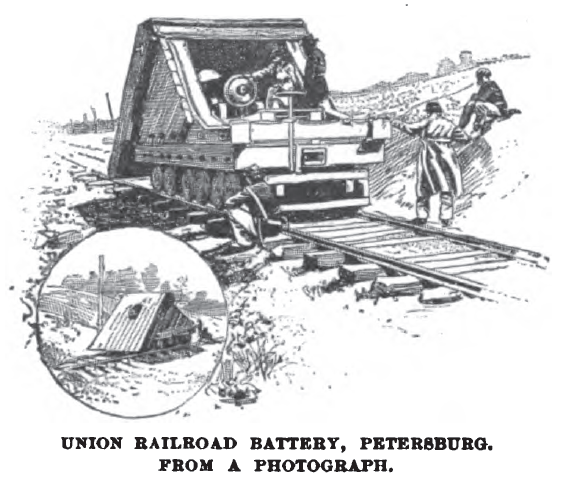
UNION RAILROAD BATTERY, PETERSBURG. FROM A PHOTOGRAPH.
burg Railroad to the Weldon Railroad, enabling us to supply, without difficulty, in all weather, the army in front of Petersburg. [See map, p. 538.] The extension of our lines across the Weldon Railroad compelled the enemy to so extend his that it seemed he could have but few troops north of the James for the defense of Richmond. On the night of the 28th the Tenth Corps, Major-General [D. B.] Birney, and the Eighteenth Corps, Major-General [E. O. C] Ord commanding, of General Butler’s army, were crossed to the north side of the James, and advanced on the morning of the 29th, carrying the very strong fortifications and intrenchments below Chaffin’s Farm, known as Fort Harrison, capturing fifteen pieces of artillery and the New Market road and intrenchments. This success was followed up by a gallant assault upon Fort Gilmer,(1) immediately in front of the Chaffin Farm fortifications, in which we were repulsed with heavy loss. [See map, p. 198.] Kautz’s cavalry was pushed forward on the road to the right of this, supported by infantry, and reached the enemy’s inner line, but was unable to get farther. The position captured from the enemy was so threatening to Richmond that I determined to hold it. The enemy made several desperate attempts to dislodge us, all of which were unsuccessful, and for which he paid dearly.(2) On the morning of the 30th [of September] General Meade sent out a
***
(1) The assault on Fort Gilmer was made by General Adelbert Ames’s division, and Brigadier-General Willlam Birney’s colored brigade of the Tenth Corps.—EDITORS.
(2) The assaults on Fort Harrison were made by the brigades of Clingman, Colquitt, Law, G. T. Anderson, and Bratton, under General R. H. Anderson, commanding Longstreet’s corps. The Confederate loss in killed and wounded was about two thousand. General George J. Stannard, commander of the Union troops at Fort Harrison, lost his arm, and General Hiram Burnham, a brigade commander, was killed.—EDITORS.
***
reconnoissance with a view to attacking the enemy’s line if it was found sufficiently weakened by withdrawal of troops to the north side. In this reconnoissance we captured and held the enemy’s works near Poplar Spring Church. In the afternoon troops moving to get to the left of the point gained were attacked by the enemy in heavy force and compelled to fall back until supported by the
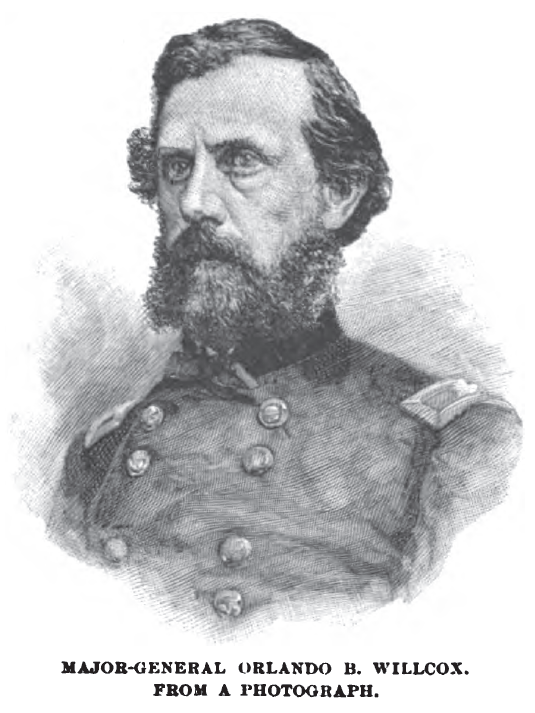
MAJOR-GENERAL ORLANDO B. WILLCOX. FROM A PHOTOGRAPH.
forces holding the captured works. Our cavalry under Gregg was also attacked, but repulsed the enemy with great loss.
On the 7th of October the enemy attacked Kautz’s cavalry north of the James and drove it back with heavy loss in killed, wounded, and prisoners, and the loss of all the artillery — eight or nine pieces.(1) This he followed up by an attack on our intrenched infantry line, but was repulsed with severe slaughter. On the 13th a reconnoissance was sent out by General Butler, with a view to drive the enemy from some new works he was constructing, which resulted in very heavy loss to us.(2)
On the 27th [of October] the Army of the Potomac, leaving only sufficient men to hold its fortified line, moved by the enemy’s right flank. The
Second Corps, followed by two divisions of the Fifth Corps, with the cavalry in advance and covering our left flank, forced a passage of Hatcher’s Run, and moved up the south side of it toward the South Side Railroad, until the Second Corps and part of the cavalry reached the Boydton plank-road where it crosses Hatcher’s Run. At this point we were six miles distant from the South Side Railroad, which I had hoped by this movement to reach and hold. But finding that we had not reached the end of the enemy’s fortifications, and no place presenting itself for a successful assault by which he might be doubled up and shortened, I determined to withdraw to within our fortified line. Orders were given accordingly. Immediately upon receiving a report that General Warren had connected with General Hancock I returned to my headquarters. Soon after I left the enemy moved out across Hatcher’s Run, in the gap between Generals Hancock and Warren, which was not closed as reported, and made a desperate attack on General Hancock’s right and rear. General Hancock immediately faced his corps to meet it, and after a bloody combat drove the enemy within his works, and withdrew that night to his old position.
In support of this movement General Butler made a demonstration on the north side of the James, and attacked the enemy on the Williamsburg road, and also on the York River Railroad. In the former he was unsuccessful; in the latter he succeeded in carrying a work which was afterward abandoned, and his forces had withdrawn to their former positions.
From this time forward the operations in front of Petersburg and Richmond, until the spring campaign of 1865, were confined to the defense and extension of our lines, and to offensive movements for crippling the enemy’s lines of communication, and to prevent his detaching any considerable force to send south. By the 7th of February our lines were extended to Hatcher’s Run, and the Weldon Railroad had been destroyed to Hicksford. . . .(3)
After the long march by General Sheridan’s cavalry, from the Shenandoah Valley, over winter roads it was necessary to rest and refit at White House. At this time the greatest source of uneasiness to me was the fear that the enemy would leave his strong lines about Petersburg and Richmond for the purpose of uniting with Johnston, before he was driven from them by battle or I
***
(1) General Kautz writes to the editors, November, 1888:
“The new lines which resulted from the success of General Butler at Fort Harrison on the 29th of September, gave my division the duty of guarding the right flank of the Army of the James with pickets as far as White’s Tavern on the Charles City road. The headquarters of the division were at Darbytown, two miles in front of the intrenched infantry line, located in the forks of the swamp which forms Four Mile Creek. The error of the position was duly represented. When the enemy at 4 A. M. on the 7th of October tried to extend his lines, the weight of the assault fell upon the cavalry. Two divisions of infantry under Longstreet engaged my force in front, while a superior force of Confederate cavalry under General Gary, covered by the timber, penetrated to the rear. The cavalry sustained the attack until 8 o’clock, giving the Tenth Corps ample time to prepare to punish the enemy very severely.”
(2) General Kautz writes:
“On the 13th of October the Cavalry Division participated in a movement under General Terry, then in command of the Tenth Corps. We engaged the Confederate cavalry on the Charles City road, while the Tenth Corps troops attacked the enemy’s intrenched line on the Darbytown road.”
(3) Among the movements on the left were the expedition, December 7th to 10th, under Warren, by which the Weldon Railroad was destroyed as far as Hicksford, and the combined movement, February 5th to 7th, under Warren and Humphreys (who on the 28th of November succeeded to the command of the Second Corps, Hancock having been detailed to organize the Veteran Corps),— which resulted in extending the Union intrenchments to Hatcher’s Run, after some severe fighting with the troops of A. P. Hill and Gordon.—EDITORS.
***
was prepared to make an effectual pursuit. On the 24th of March General Sheridan moved from White House [see p. 494], crossed the James River at Jones’s Lauding, and formed a junction with the Army of the Potomac in front of Petersburg on the 27th. During this move General Ord(1) sent forces to cover the crossings of the Chickahominy. On the 24th of March . . . instructions for a general movement [on March 29th] of the armies operating against Richmond were issued. . .
Early on the morning of the 25th the enemy assaulted our lines in front of the Ninth Corps (which held from the Appomattox River toward our left)
and carried Fort Stedman and a part of the line to the right and left of it, established themselves and turned the guns of the fort against us; (2) but our troops on either flank held their ground until the reserves were brought up, when the enemy was driven back with a heavy loss in killed and wounded, and 1900 prisoners. . . . General Meade at once ordered the other corps to advance and feel the enemy in their respective fronts. Pushing forward, they captured and held the enemy’s strongly intrenched picket-line in front of the Second and Sixth corps, and 834 prisoners. The enemy made desperate attempts to retake this line, but without success. . . .
***
(1) On the 8th of January, 1865, General E. O. C. Ord succeeded General B. F. Butler in command of the Army of the James, and the Department of Virginia and North Carolina, the designation of which was changed, February 8th, to the Department of Virginia.— EDITORS.
(2) General A. A. Humphreys, in his history, “The Virginia Campaign of ’64 and “65,” gives the following account of the object of the Confederate movement:
“General Lee proposed . . . to make a sortie in order to gain some of the works on the right of the line held by the Army of the Potomac, near the Appomattox River, and the ridge in their rear. . . . General Gordon was selected for
the service, and his corps was brought to the intrenchments nearest Petersburg, with its left on the Appomattox. The point of attack was Fort Stedman, where the opposing lines were only 160 yards apart, the pickets 50 yards apart. General Gordon was sanguine that this redoubt could be taken by a night assault, and that through the breach thus made a sufficient force could be thrown to disorganize and destroy Grant’s left wing before he could recover and concentrate his forces from the right. General Gordon says that General Lee placed at his disposal, in addition to his own corps, a portion of A. P. Hill’s and a portion of Longstreet’s, and a detachment of cavalry, in all about one-half of the army.” EDITORS.
Source:
- Grant, Ulysses S. “General Grant on the Siege of Petersburg.” Battles and Leaders of the Civil War, Volume 4, pp. 574-579 ↩

